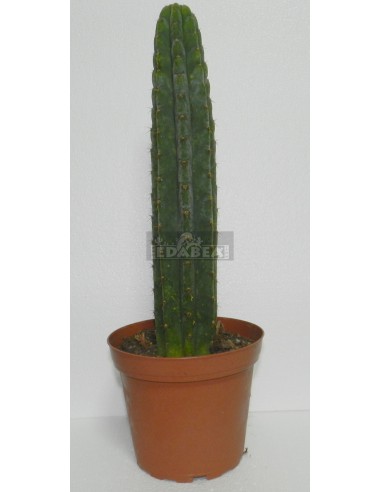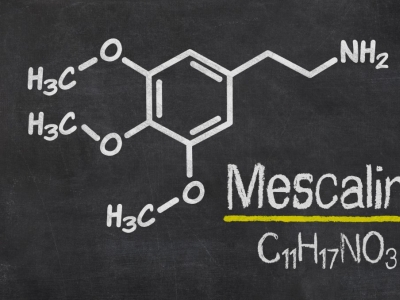Echinopsis pachanoi
Echinopsis pachanoi (formerly known as Trichocereus Pachanoi), also known as the San Pedro cactus is one of the oldest known magical plants from Ecuador and Peru.
Unrooted cuttings.
It grows in the highlands at 2000-3000 meters above sea level. In its natural habitat it often grows 3 to 4.5 meters. It is a fast growing cactus and can easily grow 30 cm. in a year.
According to the Indians, the San Pedro offers a strong trip with spiritual and colorful hallucinations. It is generally considered less strong than Peyote, but there is also less nausea at first. It can be eaten fresh or dried and also works best on an empty stomach. The skin should be peeled off, but as thinly as possible, as the active ingredients are just under the skin. The flesh is then eaten around the woody core. It can also be prepared as an infusion. Remove the spines and cut the cactus into small pieces. Cook the pieces for 2 to 3 hours in a closed pot over low heat. Allow to cool and the tea can be drunk. Its flavor is very bitter.
What to do when the effects are too overwhelming:
Breathing deeply and calmly and changing the environment and music can help. In case of overdose, contact a doctor. Keep in mind that the effects will pass.
Warning:
Mescaline cacti are not suitable for persons under the age of 18. Mescaline cacti are not suitable for people with psychological problems or a history of psychiatric problems. Do not combine mescaline cactus with medication, alcohol or drugs. Keep mescaline cactus out of the reach of children. Mescaline cactus affects responsiveness: do not do any driving or operate machinery.
Important factors for a good 'trip':
1) Do not use San Pedro if you are a minor.
2) Only use San Pedro if you feel well, both mentally and physically.
3) The effects of mescaline cactus can bring up unresolved issues, so it is not advisable to use it in low spirits or depression.
4) Using it while physically ill is not a good idea.
5) You may experience confrontations with yourself; that is, with your subconscious, ignored feelings, unprocessed life situations or fears. You need to make sure that you can surrender to the experience and deal with these feelings.
6) Don't use San Pedro on holidays or other busy occasions. Use the mescaline cactus in a trusted and quiet environment. At home or in nature.
7) Don't use San Pedro after a night of partying or binge drinking. Take your time for the psychedelic 'trip' and make sure you have no obligations the next day.
8) Travel only with good friends, with whom you can be yourself and with whom you trust. On the first psychedelic trip, it's smart to be guided by an experienced San Pedro person with whom you trust.
9) Make sure you know what to expect from San Pedro before you take it. Educate yourself. In addition to the experiences of friends, there are many interesting books and internet sites that provide excellent information.
The San Pedro cactus has become more famous in the last five years after a large number of reports of its hallucinogenic properties. It contains mescaline and can be easily found in cactus nurseries. This plant is botanically known as Trichocereus pachanoi and is native to the Andes of Peru and Ecuador. Unlike the small peyote cactus, the San Pedro is large and multi-armed. In its natural environment, it often grows to heights of 3 to 4.5 m (10 to 15 ft). Its mescaline content is lower than that of peyote (0.3 - 1.2 percent), but because of its large size and rapid growth it can provide a more economical source of mescaline than peyote. One plant can easily produce several kilos of pure mescaline once extracted.
San Pedro also contains tyramine, hordenine, 3-methoxytyramine, anhalaninine, anhalonidine, 3,4-dimethoxyphenyltylamine, 3,4-dimethoyi-4-hydroxy-B-phenyltylamine and 3,5-dimethoxy-4-hydroxy-B-phenyltylamine. Some of these substances are known sympathomimetics. Others have no detectable effects when ingested on their own. It is possible, however, that in combination with mescaline and other active compounds they may have a synergistic influence on each other and subtly alter the qualitative aspects of the experience.
The effects of San Pedro are in many ways more pleasant than those of peyote. To begin with, its taste is only slightly bitter and does not usually produce as much initial nausea. When it sinks in the full psychotropic experience is less overwhelming, calmer and nowhere near as physical as peyote.
Preparation: San Pedro can be eaten fresh or dried and taken in any of the ways described for peyote. San Pedro cuttings sold in the U.S. are generally about 90 cm tall and 8 cm in diameter. Generally, an 8-16 cm long piece will achieve the desired effect. The skin and thorns should be removed. However, the skin should not be thrown away. The green tissue near the skin contains a high concentration of mescaline. Some people chew the skin until the juices are extracted. If this is not desired, the skin can be boiled in water for several hours to make a potent tea. The woody center of the cactus cannot be eaten. What flesh remains around it can be eaten like corn on the cob. The core does not have much alkaloid content, but can be crushed and boiled to make a tea and take advantage of the little mescaline it contains.
Rooting and growing cactus cuttings: instructions
You will need a 10-15 cm ceramic pot and the soil mixture listed below. It really pays to prepare the cactus soil yourself. I have been testing with various cactus soil mixes for a few years and conclusions about what works best for this species and many, if not all, other species. I have studied the soil types of many different cacti in the wild and am able to detect wild specimens by soil type. This is a good mix:
- One part bagged topsoil sold in stores.
- One part cow manure, compost/compost or commercially available bagged compost.
- One part ground "minus grade" limestone (this bagged limestone, available at many nurseries and landscaping companies, is the finer screening of a rock crusher. It contains limestone particles ranging in size from sand to pebbles).
- Approx. 1 cup of powdered or agglomerated limestone (or dolomite) for a 15 cm pot. Peter's Professional All-Purpose Plant Nutrient (garden center)
Limestone minus grade can be substituted crushed oyster shell or crushed jibbon (pet store) or fine crushed marble. I just looked it up and a bag of crushed stone costs about $3.00 USD.
Mix the ingredients together and break up any lumps that form so that the soil has no lumps larger than the stone chunks. If you want to root a sprout or small stem, fill the pot up to 2 cm from the top, lightly squeezing the soil with your fist as you fill it. Center the sprout or cutting and squeeze the soil mixture around it to within 1 cm of the top. There should be approx. 1-2 cm of the sprout left inside the soil, just enough to keep it upright. Do not forget to press the soil. Then soak slowly and thoroughly with tap water. You can place the pot in a bucket and fill it with water up to the rim of the pot and let it soak for 15 minutes, remove and let the excess water drain out.
Place the pot in a place with direct sun exposure, if possible. The more light, the better. For faster rooting and healthier plants, it is good to make a hole in the ground in a sunny spot and bury the pot up to the edge. This stabilizes the temperature and humidity to a certain degree and encourages rooting and healthy growth. Thus they require less care and less water.
During the growing season, watering should be done when the soil feels dry when the surface is pressed with a finger. Rooting should occur quickly if the cactus is placed in full sun, the pots are buried in the soil and the soil mixture is kept cool and moist. It usually takes about 2-3 weeks. When the roots start to grow it will be noticeable because the tip will grow as well. When it starts to grow you should start providing nutrients:
Add two tablespoons of universal fertilizer per 20 liters of water to start. This is a NPK 20-20-20 fertilizer with trace elements: Trace elements are essential for cacti to have good color, growth and potency... The "blue" San Pedro is grown by maintaining adequate levels of: sun, nutrients (nitrogen, potassium, phosphorus and trace), pH and water.... Lots of water. In summer, when mixing nutrients for a San Pedro with good roots and growth, add some urea to the nutrients. For midsummer growth, provide a mixture of 2 tablespoons of 20-20-20 (see above) and 3 tablespoons of urea (46-0-0) in 20 liters of water. Do not let pots dry out completely during the growing season if it can be avoided. Outdoors in many areas nutrients are supplemented with rainwater; if not, let plants rest without nutrients every two or three inputs... Tap water or soft lime water from time to time removes salts that accumulate. Wash the pots well with a hose or rain water. And fertilize with lime with a few spoonfuls of crushed stone per pot every few months if a lot of nutrients are added. A tip: do not add too many nutrients or the roots will burn; do not let the pots dry out too much and do not expose them to full sun if you add too many nutrients. Roots need a rich, cool, moist environment.
If using the urea formula described above, add a tablespoon or two of powdered limestone or dolomite to each pot every two to three months to maintain a "sweet" chemistry in the soil. Sour pots will allow the cactus to grow, but its color and potency will be second-rate and it will not grow as fast. The lowest the pH can be is 6.8; if it is lower, the San Pedro will begin to grow light yellow. Combat diseased or yellow plants with: lime, hardwood ashes, sunlight and fertilizer.
SHIPPING RESTRICTIONS
Unfortunately we are unable to ship this product to the following countries:
Finland, Portugal, Switzerland, Norway, France, Russia, Estonia, Turkey, Hungary, Mexico, Brazil, and Canada.
For the rest of the countries please check the current legislation, there may have been changes that we are not aware of.



